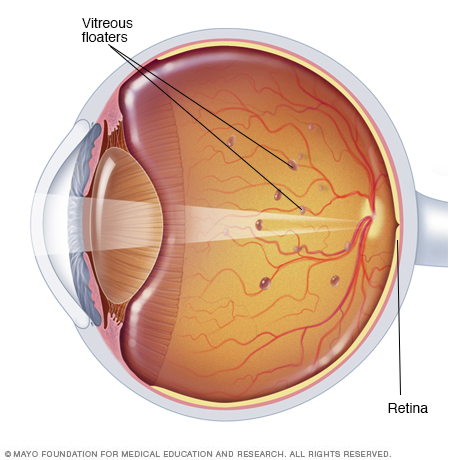On a bright day, you might look into the sky and see squiggles, dots, sparks and strands. These shadows moving inside your eye are called “floaters” and, in most cases, indicate that your eyes are getting older. Just like gray hair, wrinkles and aching joints, floaters might subtly show up one day and accumulate over time. If you have floaters, you are certainly not alone. They are one of the most common eye conditions, especially among the nearsighted. Although the likelihood of floaters increases with age, they can appear at any time in your life. If you’ve never had floaters and suddenly see them, go to your eye care clinic for a checkup. You’ll probably be told the floaters are harmless, but that doesn’t mean your questions about them should go unanswered. Here are some basics to know ahead of time.
What Causes Floaters?
Understanding the mechanics of eyesight will help you visualize why you have floaters. Inside your eye is a round gelatinous membrane called the vitreous. The vitreous is mainly water, but other elements inside it, such as protein molecules, can clump together and create specks, squiggles and cobweb strands. When light passes through the lens of your eye, these random shapes project onto the retina, or the “film” of your eye, that surrounds the vitreous. When your eye moves, so do the floaters. The resulting shadow dance is what the ancient Romans called “flying flies” (yes, they had floaters way back then too). Your doctor might dilate your pupils to look at them closely and to check for retinal detachment.
Nearsighted people of any age are more likely to get floaters if they have what’s known as posterior vitreous detachment (PVD). The reason is related to the long shape of their eyes: A longer, more oblong eye strains the retina and vitreous, causing them to pull away from each other. When the back of the vitreous separates from the retina, a small trauma might occur in the eye. Even though you don’t feel any pain or even know that such an event has occurred, bits of blood and tissue may show up as shadows in your vision. Floaters from PVD might be more difficult to ignore because of their unusual shapes and textures. One in particular is the Weiss ring, which develops when the vitreous separates from the optic nerve. The Weiss ring might be larger and darker than other floaters and have multiple strands attached to it. If PVD occurs in both eyes, you might see two Weiss rings intersecting over each other.
Can Floaters Be Removed?
Most doctors do not remove floaters because doing so could cause risky conditions like cataracts or retinal damage. Most people with floaters learn to live with them or forget their presence completely. There are a few surgical procedures to remove floaters, such as vitrectomy, but they aren’t commonly performed unless the patient’s vision is obscured. A few clinics offer laser surgery to those who’ve found living with floaters nearly impossible, but success in completely clearing the vitreous is not assured.
Removing floaters means putting your eyesight at risk, so learning to live with them is probably the best strategy. If floaters are new to you, ask your doctor for life-adjustment tips. Some people prefer to cut back on driving during the day because a white sky is a perfect canvas for floaters. If your driving is seriously affected by floaters, you might bike more frequently or use public transportation instead. At home, decorate your walls and floors with prints, patterns and tiles that prevent the shapes from showing up. Keep lights low, wear sunglasses when outdoors, and remember that, even though floaters might be a nuisance, you’ve still got your eyesight, and that’s a beautiful gift.
Posted August 7, 2017 by Silverstein Eye Centers